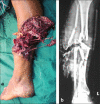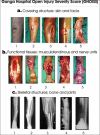The utility of scores in the decision to salvage or amputation in severely injured limbs
- PMID: 19753223
- PMCID: PMC2740356
- DOI: 10.4103/0019-5413.43371
The utility of scores in the decision to salvage or amputation in severely injured limbs
Abstract
The decision to amputate or salvage a severely injured limb can be very challenging to the trauma surgeon. A misjudgment will result in either an unnecessary amputation of a valuable limb or a secondary amputation after failed salvage. Numerous scores have been proposed to provide guidelines to the treating surgeon, the notable of which are Mangled extremity severity score (MESS); the predictive salvage index (PSI); the Limb Salvage Index (LSI); the Nerve Injury, Ischemia, Soft tissue injury, Skeletal injury, Shock and Age of patient (NISSSA) score; and the Hannover fracture scale-97 (HFS-97). These scores have all been designed to evaluate limbs with combined orthopaedic and vascular injuries and have a poor sensitivity and specificity in evaluating IIIB injuries. Recently the Ganga Hospital Score (GHS) has been proposed which is specifically designed to evaluate a IIIB injury. Another notable feature of GHS is that it offers guidelines in the choice of the appropriate reconstruction protocol. The basis of the commonly used scores with their utility have been discussed in this paper.
Keywords: Open fractures; limb injury severity score; severely injured limbs.
Conflict of interest statement
Figures






References
-
- Hansen ST., Jr Overview of the severely traumatized lower limb: Reconstruction versus amputation. Clin Orthop Relat Res. 1989;243:17–9. - PubMed
-
- Webb LX, Bosse MJ, Castillo RC, MacKenzie EJ, LEAP Study Group Analysis of surgeon-controlled variables in the treatment of limb-threatening type-III open tibial diaphyseal fractures. J Bone Joint Surg Am. 2007;89:923–8. - PubMed
-
- Hansen ST., Jr The type-IIIc tibial fracture: Salvage or amputation. J Bone Joint Surg Am. 1987;69:799–800. - PubMed
-
- Has B, Nagy A, Pavic R, Splavski B, Kristek J, Vidovic D. External fixation and infection of soft tissues close to fracture localization. Mil Med. 2006;171:88–91. - PubMed
-
- Giannoudis PV, Papakostidis C, Roberts C. A review of the management of open fractures of the tibia and femur. J Bone Joint Surg Br. 2006;88:281–9. - PubMed
LinkOut - more resources
Full Text Sources
Medical
